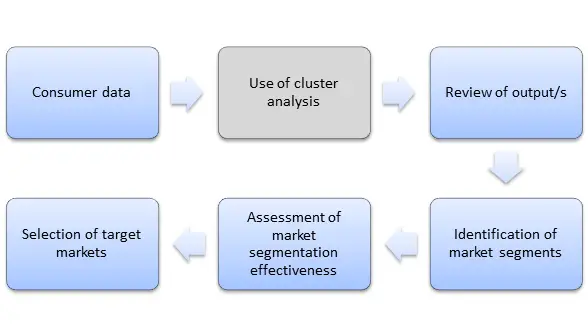Contents
Broad approaches to market segmentation
Cluster analysis is one tool that can assist in the development of market segments. There are various approaches to developing the market segments – the main approaches being:
- Using cluster analysis (discussed below and throughout this website)
- Using visual means to interpret a scatter chart (discussed on this website)
- Using a segmentation tree
- Based on management/marketing experience
- Copying/modeling competitor’s approaches to forming market segments
- Market research firm segments (VALS example)
- Arbitrarily using segmentation bases
As the primary purpose of this website is to use and understand cluster analysis the purpose of performing market segments, some of the above approaches to market segmentation have links provided for more information on those particular topics.
The role of cluster analysis in marketing
Cluster analysis is a statistical tool designed to group large amounts of data into similar sets. The word “cluster” simply refers to a related group or set.

Our purpose of using cluster analysis in marketing is to take consumer data and group it into related sets with the prime intention of establishing market segments – or perhaps looking at different array of market segments.
Our marketing goal of converting consumer data into market segments is highlighted in this diagram. As you can see, cluster analysis takes consumer data (either from a market research survey or from some form of a customer database) and helps to group it together and provide numerical outputs that can be used to develop market segments.
Therefore, cluster analysis has a clear intended outcome for the marketer – to form market segments. This means that we only want to utilize cluster analysis as a tool, and we (marketers) don’t need to get too preoccupied with the actual statistical calculation. However, this cluster analysis for marketing website mainly offers information for cluster analysis with marketing, but with some supporting technical information as well.
As an additional resource, if you are interested in the calculation side the various forms of cluster analysis, here is a link to a more detailed statistical site covering K-means clustering.
Consumer data is required
Cluster analysis requires data to run and group into segments. This data needs to be related to consumers only – not to competitors or sales or any other information that you may have. If you do not have access to numerical information on consumers, then cluster analysis will be of no use to you – and you will need one of the alternative methods of developing market segments as listed above.
The most common sources of data for use in cluster analysis include the firm’s customer database information and/or the findings from a market research survey.
Create New Market Segments and/or Modify Old Ones
You always need to keep in mind that at the end of this analysis that the purpose is to define new market segments. Ideally this should be (but not always) a new and interesting way of looking at the market. If your firm can have a different view of the market – sometimes referred to as a marketing insight – then this will help the firm gain a potential competitive advantage in the marketplace.
Alternatively, you may be looking to refresh the firm’s marketing strategy – perhaps a change is needed or the old strategy is not as successful as it was in the past. In this case, rethinking the approach to the firm’s market segmentation, using cluster analysis, could be quite beneficial – and definitely worth the analytical effort to explore.
Input into marketing strategy
While the identification of viable market segments is the key purpose of utilizing cluster analysis – and appropriate market segmentation is really the starting point for the development of your marketing strategy. Therefore, in your clustering and segmentation process, keep in mind that a suitable marketing strategy needs to be developed and implemented using your segment/s (that is, your selected target markets).
Get a better understanding of the target markets
By using cluster analysis, and then trying to make sense of the outputs, you are required to think about the market segmentation structure and how it makes sense (or otherwise). Through this process of thinking about the mix of segments, you should gain a much better understanding of the marketplace – and perhaps discover a few marketing insights along the way.
Related topics
How cluster analysis works – in simple terms
Review of the cluster analysis output
A step by step guide to the clustering and segmentation process